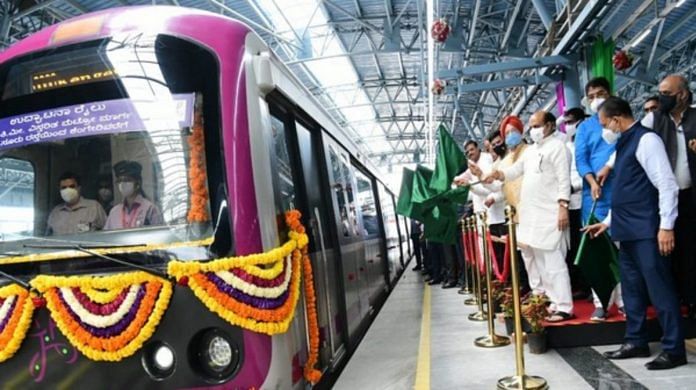Thank you dear subscribers, we are overwhelmed with your response.
bengaluru, formerly a sleepy retirement hub of the country with its narrow tree-lined lanes, a hub of Air Defence Research, and some traditional industries, has transformed into a bustling city with a 1.3 crore headcount in a matter of two decades. The sudden and unplanned growth
fueled by a spurt in IT (information technology) and ITES (information technology-enabled services) has resulted in a population influx, creating unprecedented pressure on its public infrastructure. The need for investments in infrastructure through the creation of improved road networks, and connecting those with other infrastructural hubs like suburban rails and metro rails, has become critical for continued economic growth in the city.
The idea of an underground system first emerged in the 19th century in cities like Paris and
London.
The success of metros in cities like Kolkata, Delhi, Mumbai, Noida, Kochi, and Lucknow has given birth to the Namma Metro in Bengaluru. Namma Metro is expected to have a significant positive impact on the city’s economy. Between Phases I, II, and III, the metro will cover 175 kilometers at an estimated cost of INR 11,600 crores, 30,000 crores, and 16,300 crores for each of the 3 phases. A project of this scale is a major source of direct employment through construction and maintenance and also indirectly through the supply chain.
The metro project in Bengaluru has also received the expected dose of criticism, with significant challenges being difficulties common citizens face due to construction work, environmental degradation, construction cost and future maintenance, fairness of land acquisition, etc.
The contrarian views pose a valid question: whether a developing country like India can afford such an expensive and ambitious project instead of focussing on social development projects and alternate welfare schemes. It must be considered, however, if these counters present a substantive argument that outweighs a metro’s commercial and social advantages.
The presence of a functional metro network drives economic expansion in a region by catalyzing development, enhancing transportation efficiency, attracting skilled professionals, and improving the overall quality of life, thereby stimulating investment and growth in the area.
Every mention of Bengaluru lately invariably generates the topic of unmanageable traffic and that Bengaluru has the second-slowest commute time in the country with an average speed of 18.7 kmph.
The adoption of public transport, especially the Metro, can make a dent in addressing the traffic challenge. A recent Whitefield trial measured the metro covering a 13-kilometer stretch in an impressive 12 minutes with an average speed of 80 kmph.
The inordinate amount of time spent on the daily commute is detrimental to employee productivity, even discouraging employees from showing up in the office. The Namma Metro would address this issue.
However, the reach of the metro will be restricted unless there is seamless connectivity with alternate modes of transportation. BMRCL has built common hubs with traditional railway systems in key locations like City Railway Station. Inter-connectivity with Southern Railways provides leverage for what Metro brings. BMTC is also cooperating with the metro
authority to strengthen bus-metro linkages, especially in larger stations like Bypanahalli. The ongoing project in Phase III to connect Kempegowda International Airport will also go a long way to ease the inter-city commute from Bengaluru.
As a key non-financial focus for nations across the globe right now, ESG (environmental, social, and governance) concerns top everyone’s priorities. Metro provides an environmentally sustainable alternative to vehicular pollution.
Bengaluru’s car ownership rate is 780 vehicles per 1,000 people, which contributes 10 million metric tonnes of CO2 annually. The effect of that is visible in the Bengaluru Air Quality Index (AQI), which is often recorded above 100 by the Central Pollution Control Board. This makes Bengaluru one of the top 10 polluted cities in India. The transport sector alone
contributes to nearly all carbon monoxide (CO) emissions, more than 80% of nitrogen oxide (NO), 40% of volatile organic compounds, 20% of sulphur dioxide (SO2), and 35% of PM10. The numbers are staggering. A broader adoption of electrically operated metro lines can potentially make a significant difference.
The benefits of metro line connectivity are irrefutable. The positive impact it has on the economic growth of a city and improving the quality of life for its residents has been proven repeatedly in other countries and India.
The debate and the contrarian view on ‘Namma Metro’ are rarely on its usefulness. As a city, Bengaluru is uniquely positioned. It is a victim of its success. It is growing at a fast pace with the potential to continue that trajectory, but its infrastructure is crumbling under that pressure and demands immediate attention.
The Metro brings the prospect of an improved quality of life. The difficulties are short-term, but the benefits are hopefully substantial.
These pieces are being published as they have been received – they have not been edited/fact-checked by ThePrint.


